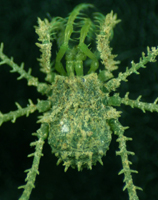Podoctidae Last updated September 27, 2025 Family of harvestmen/daddy longlegs
Podoctidae is a family of the harvestman infraorder Grassatores with about 130 described species. [ 1]
Description Body length ranges from 2.5 to 5 millimeters, with leg length ranging from three to almost thirty mm. While most species are brown to yellow, some are deep green. The legs may be ringed in black and yellow. The penis is uniquely built. [ 1]
Relationships Although Podoctidae are currently included in Samooidea , and are surely Grassatores , there is no obvious relationship with any family. [ 1]
Name The name of the type genus is derived from Ancient Greek podos "foot" and oktis "spine", referring to the ventral row of long spines in femur I. [ 1]
Genera A detailed list of included species is HERE , which along with generic list below are derived from (as of mid. 2024) the World Catalog of Opiliones . [ 3] Older versions were largely from the now defunct Joel Hallan's Biology Catalog . [ 4]
Erecananinae Erecanana Strand, 1911 — Kenya , Tanzania , etc. (=Sub-Saharan Africa ), inc. Madagascar , Réunion (9 species) Iyonus Suzuki, 1964 — Japan (1 species) Lomanius Roewer, 1923 — China , Malaysia , Indonesia (Java ), Philippines , Taiwan , Vietnam (7 species) Paralomanius Goodnight & Goodnight, 1948 — Philippines , Palau (2 species) Strandibalonius Roewer, 1912 — Indonesia (Borneo , Sulawesi ), Papua New Guinea , Micronesia , Melanesia (16 species)Ibaloniinae Asproleria Roewer, 1949 — New Guinea (1 species) Austribalonius Forster, 1955 — Australia (1 species) Ceylonositalces Özdikmen, 2006 — Sri Lanka (1 species) [Replacement name for Eusitalces Roewer, 1915 ] Gargenna Roewer, 1949 — Indonesia (Nusa Tenggara Barat ) (1 species) Heteroibalonius Goodnight & Goodnight, 1947 — Indonesia (Papua ) (1 species) Heteropodoctis Roewer, 1912 — Papua New Guinea /Indonesia (South Papua ) (1 species) Holozoster Loman, 1902 — Seychelles (1 species) Ibalonianus Roewer, 1923 — Papua New Guinea , Indonesia (Papua Barat), (Maluku Islands ) (4 species) Ibalonius Karsch, 1880 — Philippines , New Caledonia , Seychelles , New Guinea, Solomons (16 species) Leytpodoctis Martens, 1993 — Philippines (1 species) Orobunus Goodnight & Goodnight, 1947 — Papua New Guinea , Indonesia (Papua) (1 species) Paramesoceras Roewer, 1915 — Papua New Guinea (1 species) Pentacros Roewer, 1949 — Indonesia (1 species) Podoctinus Roewer, 1923 — Papua New Guinea (1 species) Proholozoster Roewer, 1915 — Papua New Guinea (1 species) Santobius Roewer, 1949 — Melanesia (4 species) [see also Ibantila Silhavy, 1969 for Santobius cubanus — Cuba (introduced)] Sitalcicus Roewer, 1923 — Seychelles (3 species) Waigeucola Roewer, 1949 — Indonesia (1 species)Podoctinae Baramella Roewer, 1949 — Malaysia (Sarawak ) (1 species) Baramia Hirst, 1912 — Brunei , Malaysia (Sarawak ), Indonesia (Kalimantan) (5 species) Baso Roewer, 1923 — Indonesia (Sumatra ) (1 species) Basoides Roewer, 1949 — Indonesia (Sumatra ) (1 species) Bistota Roewer, 1927 — India (1 species) Bonea Roewer, 1913 — Indonesia , Philippines (10 species) [Note: Previously in Ibaloniinae] Borneojapetus Özdikmen, 2006 — Indonesia/Malaysia ("Borneo ") (1 species) [Replacement for Japetus Roewer, 1949] Centrobunus Loman, 1902 — Seychelles (1 species) Dongmoa Roewer, 1927 — Japan , Vietnam (2 species) Eupodoctis Roewer, 1923 — India , Sri Lanka (2 species) Eurytromma Roewer, 1949 — Sri Lanka (1 species) Gaditusa Roewer, 1949 — Borneo (1 species) Hoplodino Roewer, 1915 — Indonesia , Singapore (4 species) Idjena Roewer, 1927 — Indonesia (Java ) (1 species) Idzubius Roewer, 1949 — Japan (1 species) Laponcea Roewer, 1936 — Mauritius (1 species) Lejokus Roewer, 1949 — Malaysia (Sarawak ) (1 species) Lundulla Roewer, 1927 — Malaysia (Sarawak ) (1 species) Metapodoctis Roewer, 1915 — Taiwan , Thailand (2 species) Neopodoctis Roewer, 1912 — Sri Lanka (2 species) Oppodoctis Roewer, 1927 — Philippines (1 species) Peromona Roewer, 1949 — Seychelles (1 species) Podoctellus Roewer, 1949 — Malaysia (Johore ) (1 species) Podoctis Thorell, 1890 — Malaysia (Pinang ) (1 species) Podoctomma Roewer, 1949 — Indonesia (Java ) (1 species) Podoctops Roewer, 1949 — Indonesia (Sumatra ) (1 species) Pumbaraius Roewer, 1927 — India (2 species) Sibolgia Roewer, 1923 — Indonesia (Sumatra ) (1 species) Stobitus Roewer, 1949 — Malaysia (1 species) Tandikudius Roewer, 1929 — India (1 species) Trencona Roewer, 1949 — — Indonesia/Malaysia ("Borneo ") (1 species) Trigonobunus Loman, 1894 — Indonesia (West Kalimantan ) (1 species) Tryssetus Roewer, 1936 — Mauritius (1 species) Vandaravua Roewer, 1929 — India (1 species)References 1 2 3 4 5 Kury, Adriano B. (2007): Podoctidae Roewer, 1912. In: Pinto-da-Rocha et al. 2007: 221ff ↑ Bartel, Christian; Dunlop, Jason A.; Sharma, Prashant P.; Selden, Paul A.; Tarasov, Pavel E.; Ren, Dong; Shih, Chungkun (July 2022). "Four new Laniatorean harvestmen (Arachnida: Opiliones) from mid-Cretaceous Burmese amber" . Palaeoworld . 32 : 124– 135. doi : 10.1016/j.palwor.2022.06.006 . S2CID 250401481 . ↑ "Podoctidae" . Kury, A. et al. (2023). WCO-Lite: World Catalogue of Opiliones . Retrieved 2024-07-10 . ↑ "Podoctidae" . Joel Hallan's Biology Catalog (Archive version. October 2014) . Archived from the original on 13 October 2014. Retrieved 2024-07-10 . Further reading:
Pinto-da-Rocha, R., Machado, G. & Giribet, G. (eds.) (2007): Harvestmen - The Biology of Opiliones. Harvard University Press ISBN 0-674-02343-9 This page is based on this
Wikipedia article Text is available under the
CC BY-SA 4.0 license; additional terms may apply.
Images, videos and audio are available under their respective licenses.
